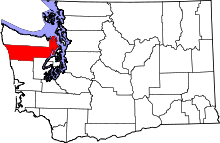Kalaloch, Washington

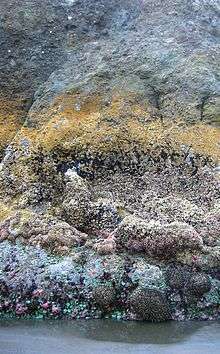
Kalaloch /ˈkleɪlɒk/ is an unincorporated resort area entirely within Olympic National Park in western Jefferson County, Washington, United States.[1] Kalaloch accommodations (lodge, cabins, and campgrounds) are on a 50-foot (15 m) bluff overlooking the Pacific Ocean, west of U.S. Highway 101 on the Olympic Peninsula, north of the reservation of the Quinault Indian Nation.
The name Kalaloch is a corruption of the Quinault term k'–E–le–ok, pronounced Kq–â-lā'–ȯk, meaning "a good place to land", "canoe launch and landing", or "sheltered landing". The site was one of the few safe landing sites for dugout canoes between the Quinault River and Hoh River.[2]
History
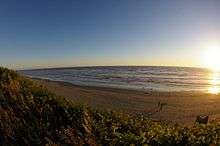
Artifacts discovered in Olympic National Park are evidence early humans inhabited the Olympic Peninsula 6,000 to 12,000 years ago.[3] Today eight tribes (Hoh, Jamestown S'Klallam, Elwha Klallam, Makah, Port Gamble, S'Klallam, Quileute, Quinault, and Skokomish) live in reservations along the shores.[4] In 1855 and 1856 Olympic Peninsula tribes ceded their lands and waters to the federal government.[3]
In 1889, Washington became a state. President Grover Cleveland created the Olympic Forest Reserve in 1897, which was renamed to Olympic National Forest in 1907.[3] Charles W. Becker, Sr., purchased a 40-acre (16 ha) coastal plot just south of where Kalaloch Creek meets the Pacific Ocean in 1925. Becker used milled lumber from driftwood logs that washed up on the beach to build the main lodge and cabins.[5]
To preserve some of Washington's primeval forest lands, in 1938 President Franklin D. Roosevelt designated 898,000 acres (363,000 ha) as Olympic National Park. Two years later, President Roosevelt added 300 square miles (780 km2) to the park. President Harry S. Truman added 75 miles (121 km) of coastal wilderness to the Park in 1953, including the Kalaloch area. In 1976 the Olympic National Park was designated as an International Biosphere Reserve.[3] The National Park Service purchased the Becker property in 1978 and renamed it Kalaloch Lodge.[5] Olympic National Park was designated in 1981 as a World Heritage Site. In 1988, Congress approved the designation of 95 percent of the park as the Olympic Wilderness.[3]
Weather and climate
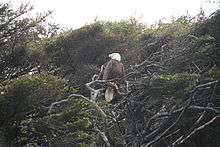
Kalaloch weather is influenced by prevailing Pacific winds and two temperate rain forests, the Hoh rainforest and the Quinault rainforest. Annual rainfall at Kalaloch is measured in feet: on average, 8.5 feet (2.6 m) fall annually.[6]
- Spring – 8.94 inches (227 mm) per month average
- Summer – 3.13 inches (80 mm) per month average
- Fall – 11.17 inches (284 mm) per month average
- Winter – 17.12 inches (435 mm) per month average
Recreation
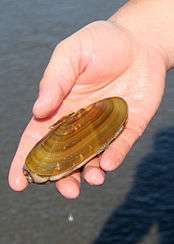
About 73 miles (117 km) of beach in the Olympic National Park provide beachcombing opportunities. At Kalaloch, seven area beach trails lead to coastal hikes and Kalaloch Creek. Fishing possibilities at Kalaloch include surf perch, salmon, or native trout, or at low tide visitors may dig for razor clams.[7] Bald eagles, black-legged kittiwakes, red-throated loons, black scoters, and brown pelicans are among birdwatchers' sightings at Kalaloch.[8] From Kalaloch bluffs, whale watchers may see migratory gray whales, and sea lions, harbor porpoise, harbor seals, sea otters and orcas may also be spotted.[9]
The National Park Service staffs a ranger station in the area during the summer.[10]
Resort accommodations
Kalaloch offers three types of accommodations: lodge, cabins, and campground.
Kalaloch Lodge[11] has been named "Best Northwest Escapes winner for Best Sunsets and Best storm Watching"[12] by Seattle NBC affiliate KING-TV.
Forty cabins are available, including six on the bluff overlooking the ocean. The Kalaloch Lodge proprietors note, In order to enhance your enjoyment of the surrounding natural beauty, all Kalaloch Lodge Cabins do NOT have in-room phones, WiFi/Internet access, or televisions.[13]
Kalaloch Campground, with 166 camp sites, is the only campground in Olympic National Park accepting summer reservations.[14][15]
See also
References
- ↑ "Kalaloch". Geographic Names Information System. United States Geological Survey.
- ↑ Parratt, Smitty (1984). Gods & goblins: A Field Guide to Place Names of Olympic National Park. CP Publications. p. 78. ISBN 0-914195-00-X..
- 1 2 3 4 5 "Amazing Stories of Kalaloch Lodge". DNC Parks & Resorts at Kalaloch. Retrieved May 12, 2014.
- ↑ "Olympic: Ancient Peoples and Area Tribes" (PDF). National Park Service. Retrieved May 12, 2014.
- 1 2 "Olympic National Park History". DNC Parks & Resorts at Kalaloch. Retrieved May 12, 2014.
- ↑ "Olympic National Park Weather". Great Outdoor Recreation Pages. Retrieved May 12, 2014.
- ↑ "Olympic National Park Fishing and Clamming". DNC Parks & Resorts at Kalaloch. Retrieved May 11, 2014.
- ↑ "Kalaloch Birdwatching in Olympic National Park". DNC Parks & Resorts at Kalaloch. Retrieved May 11, 2014.
- ↑ "Washington Coast Whale Watching". DNC Parks & Resorts at Kalaloch. Retrieved May 12, 2014.
- ↑ "Olympic National Park: Kalaloch Area". National Park Service. Retrieved November 14, 2012.
- ↑ "Kalaloch Lodge at Olympic National Park – Hotel, Lodging & Cabins". DNC Parks & Resorts at Kalaloch. Retrieved May 12, 2014.
- ↑ KING-TV. "Best of Northwest Escapes". Retrieved October 30, 2015.
- ↑ "Olympic National Park Cabins". DNC Parks & Resorts at Kalaloch. Retrieved May 11, 2014.
- ↑ "Kalaloch Lodge Group Campground". DNC Parks & Resorts at Kalaloch. Retrieved May 11, 2014.
- ↑ "Olympic National Park - Kalaloch" (PDF). National Park Service. U.S. Government. Retrieved June 24, 2016.
External links
- Geology of the Washington Coast between Point Grenville and the Hoh River
- Kalaloch Lodge
- KING-TV's Best Sunset & Best Storm Watching
- National Park Service
- Whale Trail
Coordinates: 47°36′16″N 124°22′15″W / 47.60444°N 124.37083°W
